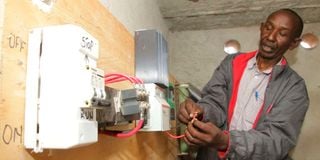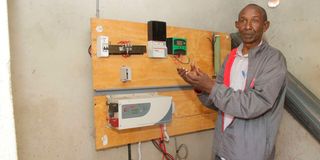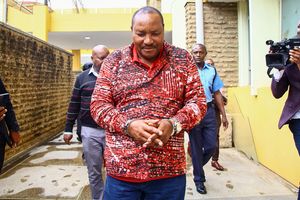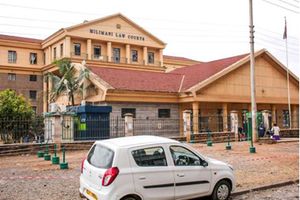Premium
Nyeri Jua Kali artisan spins profits from wind power

Dalton Mathenge explains how wind power is connected with the mains at Gatuamba village in Nyeri County on August 30, 2023. The jua kali artisan has assembled a wind power system in his locality to supplement the power.
The skyline of Gatuamba village in Nyeri makes for any other locality save for the towering wind turbines dominating the area. They are landmarks testament to the locals’ embrace of renewable energy.
Even though the village is a beneficiary of the Rural Electrification and Renewable Energy Corporation (Rerec), most of the well-off locals have installed wind power systems in their homes as supplementary power sources.
The wind power system is the brainchild of 55-year-old Dalton Mathenge, a Jua Kali artisan based in Naromoru town, four kilometres from Gatuamba.
It features a metal tower, blades crafted from hardwood and an alternator generator situated inside the base of the wind turbine and constructed from magnets, coiled copper, and automotive shafts.
The turbine is connected to a control room, which optimises and manages the electrical power extracted from wind.
Mr Mathenge says his innovation works in the same way a modern wind turbine does.
The turbine has a tail, which controls the direction in which the blades will rotate. These blades are attached to a shaft that is connected to a generator. And as the blades turn, they cause the shaft to turn too and the rotational motion is converted into mechanical energy.
Inside the generator, the shaft turns a series of magnets around a coil of wire thus producing electrical energy that is then transmitted to the control room.

Dalton Mathenge explains how wind power is connected with the mains at Gatuamba village in Nyeri County on August 30, 2023. The jua kali artisan has assembled a wind power system in his locality to supplement the power.
“In the control room, the energy is converted into direct current, which can be stored in batteries for later use. Any excess energy is automatically converted back into alternating current, making it suitable for use by household appliances,” he says.
The turbines are not noisy and produce 1,000 watts of electricity each.
The motivation to create a wind power system he says, “stemmed from growing up without electricity.”
His locality was connected to electricity only after the enactment of Rerec in 2019, which successfully implemented rural electrification projects.
Three years prior, he had begun working on a wind power generation project. Previous attempts had been unsuccessful, butMr Mathenge says his fortunes changed in 2016, when some foreign students from the Delft University of Technology in the Netherlands visited his Jua Kali workshop Naromoru town.
“They said they were collecting motor vehicle spare parts to put together a wind power energy project for a grade towards their final examination,” he explains.
He showed them his unfinished wind turbine, whose generator he had unsuccessfully tried to operate. The students agreed to collaborate with him to make good on his wind-power project.
“We secured a Sh20 million grant from a global environmental organisation to fund our endeavour,” he recounts.
It took the team nearly a year to complete the project successfully and test it locally.

Dalton Mathenge explains how alternating current (AC) power from a wind driven generator is converted to direct current (DC) and stored in batteries inside a control room.
By the time his group members returned to the Netherlands, Mr Mathenge found himself fully equipped with the requisite skills to undertake such a project independently. A few years later,, he secured his first client — a Kenyan based in the United Kingdom but has a home in Naromoru.
“The customer, who was seeking an alternative source of energy, decried the lack of energy from the abundant wind power in the country. He had, in fact, considered importing materials and invite a technician from the UK to handle one such installation, but it was proving a costly undertaking,” Mr Mathenge explained. In reply, the Jua Kali artisan spent over Sh200,000 to create, design and install a wind power energy system for his client, who has since used it as an alternative power source in his household.
Ever since, he has secured more customers from referrals.
Before constructing a wind power system for a client, Mr Mathenge conducts a site visit where the turbine would be placed. “The location should have consistent and strong winds with speeds of three metres per second or more,” he notes, adding that the coastal regions, hilltops and open plains are ideal sites.
He also takes into account the bird populations in these areas, as they could intersect with migratory flight paths and the spinning blades could pose a risk to the birds.
Mr Mathenge crafts the blades from hardwood trees because they are durable and resistant to breaking. “The tip of the blade should be very thin. If it breaks, it will disrupt its balance causing the alternator in the generator to become unstable,” he explains. The blades are also coated with upholstery paint to protect them from decay. Such a wind turbine requires servicing every five years.

Dalton Mathenge services a wind turbine at Gatuamba village in Nyeri County on August 30, 2023.
While establishing a wind-energy power system has long-term benefits and potential cost savings, it requires a significant initial investment, which can be a deterrent.
Mr Mathenge charges Sh350,000 for a wind energy power system, including labour and material costs. He completes the project in a month.
However, current conditions in the country’s power sector, characterised by rampant fraud, electricity theft, high electricity prices, system losses and frequent blackouts, have worked to his advantage. He says, many Kenyans are now seeking alternative sources of power. And to his delight and testimony, his clients include hotels, large-scale farmers, ranchers in Laikipia, and Technical Training and Vocational colleges. Such clients, he says, often supplement the wind power energy systems with solar energy.
His expertise in the sector has led him to land occasional teaching opportunities to engineering students at the Dedan Kimathi University of Technology and Strathmore University.
Mr Mathenge says he began his journey at the Laikipia Polytechnic, where he pursued a certificate course in metalwork and welding. His passion for machines led him to join a garage workshop after his studies.
However, he later left to establish his own workshop. The business, which is now under his company, Dalton Green Energy Kenya, has diversified its products from making chain-link fencing materials, posho mills and automobile repairs, to currently constructing wind power energy systems.
However, his wind power energy system is yet to be certified, but that is work-in-progress as he is collaborating with the Kenya Industrial Research and Development Institute (KIRDI) to ensure his innovation meets national standards.
Mr Mathengee has also applied for intellectual property rights registration through the Kenya Industrial Property Institute (KIPI).





